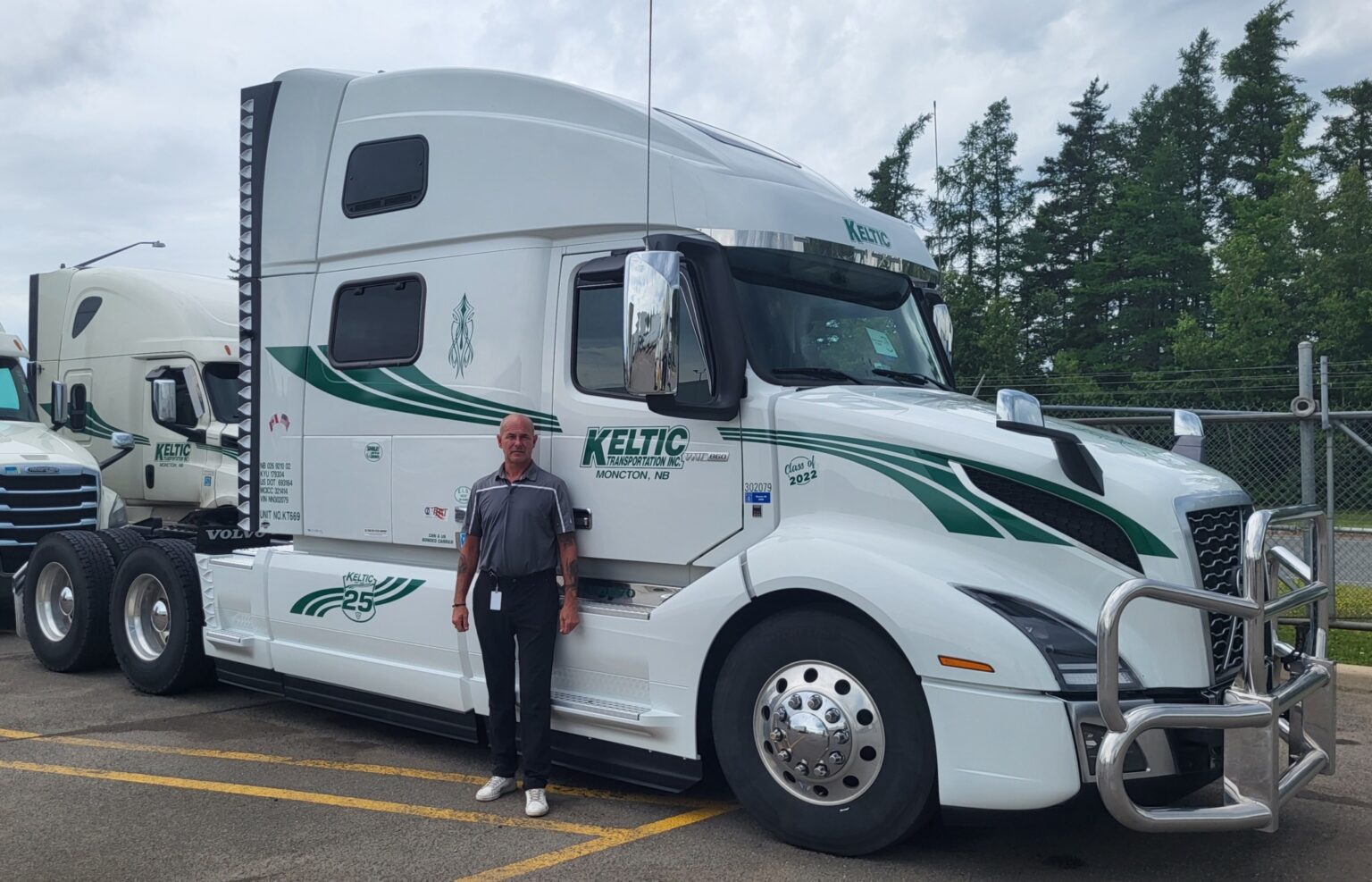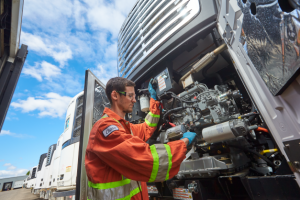How to extend trailer life

Trailers are suddenly getting a newfound appreciation in the trucking industry, thanks to long lead times at factories, the increased adoption of drop-and-hook freight, and higher – much higher – acquisition costs.
Speaking at industry forecaster FTR’s annual Transportation Conference, Stoughton Trailers vice-president of sales and marketing David Giesen said the cost of a dry van has doubled over the past three years. Some customers have seen as many as eight price increases from the time they were first quoted, until they could finally take delivery of the unit.
“When given the opportunity to cancel their order, they don’t want to cancel,” he said of customers.
Higher purchase prices aren’t a result of opportunistic trailer manufacturers padding their margins. They are struggling themselves, with the higher costs of raw materials that go into making a trailer, combined with supply chain-related component shortages and a lack of people to actually build the equipment.

Trailer maintenance in shopDon’t forget the TAB (tires, airlines and brakes) when trying to extend trailer life. (Photo: Trailcon Leasing)

Trailcon’s new Reefer Refresh program enables refrigerated trailers to be run longer after the TRU is given a fresh lease on life. (Photo: Trailcon Leasing)
Many units that would’ve been retired or put into storage applications are still on the road,” Gorman said.
His advice to fleets that are extending trailer life is to increase equipment inspections. “In addition to the annual safety inspection and driver pre-trips, we recommend additional preventive maintenance inspections throughout the year. Retorque the nuts on wheel ends, [monitor] brake adjustment, grease where and when needed,” he advised, adding LED lights also must have sufficient dielectric grease applied to support a longer service life.
Give extra attention to landing gear, slack adjusters, clevis pins and other moving parts, he added. Jamie Hillier, vice-president of operations and maintenance with Trailcon Leasing agreed, suggesting to keep an eye on the TAB (tires, airlines and brakes), just like you would at a pub.
“If a driver or maintenance technician is looking at those three items, they can easily extend the life of the trailer significantly,” he said. That means more than whacking tires with a hammer during a pre-trip inspection to indicate roadworthiness.
“Make sure you’re sticking tires [with an air gauge],” he said. “Put the gauge in and see what the actual pressure is. Check for cracks in airlines, and listen for small audible leaks. Those could turn bad for you when the trailer breaks down in the middle of nowhere. Make sure the lines aren’t worn, chafed, or crimped. Check the brakes to make sure there are no cracks and that they’re in adjustment. Any trailer that comes into our service bays, those are the three items we constantly and religiously are looking at.”
Extending equipment life
With more than 10,000 trailers in its own network and responsibility for maintaining another 20,000 customer trailers, Trailcon responded quickly to the supply shortage. When Hillier heard early this year there was a looming brake drum shortage, he purchased two shipping containers full of them and stored the components at its Brampton, Ont., facility.
“Historically, we would order a skid here or there,” he said.
Now the focus is on extending equipment life as much as possible. “Make sure you treat that component like it’s a wet cloth,” he tells technicians. “You have to wring as much water as you can out of every piece of that component. Getting life out of that component is vital in times of parts uncertainty.”
Trailcon has added two new programs to help fleets safely extend trailer life. TrailerCare is a full-service leasing program that incorporates additional inspections by the company’s licensed technicians with the aim of extending service life. For refrigerated fleets, it has added a new Reefer Refresh program. This entails a comprehensive review of the trailer refrigeration unit (TRU) once it has reached about 30,000 hours of use, where problems normally begin to rear their head.
The company will replace or rebuild wear items such as compressors, condensers and starters, then add another PM based on that reefer’s specific use case. Some fleets are doing their own refurbishments to squeeze a few extra years of use out of their trailers.
DIY refurbishing
Lloyd De Merchant, director of fleet maintenance with Moncton-based Keltic Transportation, said he will sandblast and paint the bogey on an aging trailer, and inspect, repair or replace anything that has corroded. He has even replaced the side panels on van trailers and has gotten as many as eight to 10 additional years of use.

Lloyd De Merchant, director of fleet maintenance with Moncton-based Keltic Transportation, has been refurbishing trailers to get an extra eight to 10 years of service from them. (Photo: Supplied)
ures
/
Business Management
How to extend trailer life
by James Menzies
October 11, 2022
@JamesMenzies
Trailers are suddenly getting a newfound appreciation in the trucking industry, thanks to long lead times at factories, the increased adoption of drop-and-hook freight, and higher – much higher – acquisition costs.
Speaking at industry forecaster FTR’s annual Transportation Conference, Stoughton Trailers vice-president of sales and marketing David Giesen said the cost of a dry van has doubled over the past three years. Some customers have seen as many as eight price increases from the time they were first quoted, until they could finally take delivery of the unit.
“When given the opportunity to cancel their order, they don’t want to cancel,” he said of customers.
Higher purchase prices aren’t a result of opportunistic trailer manufacturers padding their margins. They are struggling themselves, with the higher costs of raw materials that go into making a trailer, combined with supply chain-related component shortages and a lack of people to actually build the equipment.
Trailer maintenance in shopDon’t forget the TAB (tires, airlines and brakes) when trying to extend trailer life. (Photo: Trailcon Leasing)
“At the end of the day, the trailer is made up of commodities,” said Aaron Gorman, Manac’s vice-president of sales – Ontario and Western Canada, in an interview with TruckNews.com. “Steel, aluminum, wood, rubber and plastic.”
Steel and aluminum prices have been particularly volatile over the past couple years as global economies have emerged from the pandemic-related shutdowns of production facilities. The good news is that Gorman is seeing some steadiness return to commodity prices, potentially helping to stabilize trailer prices.
“Could they come down? Yes. To pre-pandemic pricing? Absolutely not,” he said.
Giesen offered a similar response when an FTR conference attendee asked about pricing. “The pricing that’s in place now, I’d predict is going to stay in place for 2023,” he said, adding that lower raw material costs don’t necessarily translate to cheaper trailers. Conversion fees charged by aluminum mills, for instance, mitigated any pricing relief on rails the manufacturer hoped to see when aluminum prices dropped.
Increasing inspections and maintenance
So, with no immediate end to trailer supply shortages or acquisition costs, maintenance of this oft-overlooked asset has suddenly become front of mind for technicians and fleet maintenance managers. For others, trailers are simply being run longer – but extending trade cycles without proper maintenance comes with its own risks.
servicing a reeferTrailcon’s new Reefer Refresh program enables refrigerated trailers to be run longer after the TRU is given a fresh lease on life. (Photo: Trailcon Leasing)
“Many units that would’ve been retired or put into storage applications are still on the road,” Gorman said.
His advice to fleets that are extending trailer life is to increase equipment inspections. “In addition to the annual safety inspection and driver pre-trips, we recommend additional preventive maintenance inspections throughout the year. Retorque the nuts on wheel ends, [monitor] brake adjustment, grease where and when needed,” he advised, adding LED lights also must have sufficient dielectric grease applied to support a longer service life.
Give extra attention to landing gear, slack adjusters, clevis pins and other moving parts, he added. Jamie Hillier, vice-president of operations and maintenance with Trailcon Leasing agreed, suggesting to keep an eye on the TAB (tires, airlines and brakes), just like you would at a pub.
“If a driver or maintenance technician is looking at those three items, they can easily extend the life of the trailer significantly,” he said. That means more than whacking tires with a hammer during a pre-trip inspection to indicate roadworthiness.
“Make sure you’re sticking tires [with an air gauge],” he said. “Put the gauge in and see what the actual pressure is. Check for cracks in airlines, and listen for small audible leaks. Those could turn bad for you when the trailer breaks down in the middle of nowhere. Make sure the lines aren’t worn, chafed, or crimped. Check the brakes to make sure there are no cracks and that they’re in adjustment. Any trailer that comes into our service bays, those are the three items we constantly and religiously are looking at.”
Extending equipment life
With more than 10,000 trailers in its own network and responsibility for maintaining another 20,000 customer trailers, Trailcon responded quickly to the supply shortage. When Hillier heard early this year there was a looming brake drum shortage, he purchased two shipping containers full of them and stored the components at its Brampton, Ont., facility.
“Historically, we would order a skid here or there,” he said.
Now the focus is on extending equipment life as much as possible. “Make sure you treat that component like it’s a wet cloth,” he tells technicians. “You have to wring as much water as you can out of every piece of that component. Getting life out of that component is vital in times of parts uncertainty.”
Trailcon has added two new programs to help fleets safely extend trailer life. TrailerCare is a full-service leasing program that incorporates additional inspections by the company’s licensed technicians with the aim of extending service life. For refrigerated fleets, it has added a new Reefer Refresh program. This entails a comprehensive review of the trailer refrigeration unit (TRU) once it has reached about 30,000 hours of use, where problems normally begin to rear their head.
The company will replace or rebuild wear items such as compressors, condensers and starters, then add another PM based on that reefer’s specific use case. Some fleets are doing their own refurbishments to squeeze a few extra years of use out of their trailers.
DIY refurbishing
Lloyd De Merchant, director of fleet maintenance with Moncton-based Keltic Transportation, said he will sandblast and paint the bogey on an aging trailer, and inspect, repair or replace anything that has corroded. He has even replaced the side panels on van trailers and has gotten as many as eight to 10 additional years of use.
Lloyd De Merchant, director of fleet maintenance with Moncton-based Keltic Transportation
Lloyd De Merchant, director of fleet maintenance with Moncton-based Keltic Transportation, has been refurbishing trailers to get an extra eight to 10 years of service from them. (Photo: Supplied)
Gorman said DIY refurbishments are a good temporary solution in this environment, as long as they’re done properly.
“This is something we will see for a while, until we all catch up again,” he said. “When doing this, the service centers and maintenance centers will also have to look at the overall structural integrity of the trailer. Items such as the degradation of the floor over the years, the running gear, and overall condition of the structure of the trailer. If they pass a safety inspection then replacing other components around it does make sense.”
If there’s some good that can come of this trailer supply shortage, it’s that many of the practices being implemented out of necessity to extend trailer life are likely to continue on even when trailers become more readily available. It’s also forcing fleets and maintenance managers to place greater value on the lowly trailer, traditionally thought of as little more than an inexpensive box on wheels.
“One thing some fleets have told me is that the shortage of equipment has made them more efficient.”
Aaron Gorman, Manac
“One thing some fleets have told me is that the shortage of equipment has made them more efficient,” said Gorman. “They are doing more live loading and unloading and better capitalizing on what they have in their trailer pool.”
More drop and hook
Other fleets, however, are increasing their trailer-to-truck ratios in an attempt to better utilize drivers through increased use of drop-and-hook models. Few things may be more difficult to find than a new trailer, but an experienced driver is one of them – and fleets are gravitating to drop-and-hook shipments to keep drivers moving. But this can create a new problem, as trailers can be left sitting in yards waiting for pickup, rather than rolling down the highway.
“There’s brake seizing and flatspotting on tires,” Gorman said of a couple potential hazards. “They also get pooling water and snow on top of them. Fleets want to keep those trailers moving.”
With trailer prices surging, fleets are also putting more attention into spec’ing for longevity, something that Gorman is pleased to see.
“Invest in the product from Day 1,” he advised. “Put thought into the application and where the equipment will be traveling…Heavy-duty applications will require additional crossmembers and possible extended slider rails, a few more roof bows in key high-stress locations, a thicker more robust rear door frame assembly, a thicker floor, and additional waterproofing throughout the trailer. Nickle-and-diming over $100 [upgrades] has gone.”
